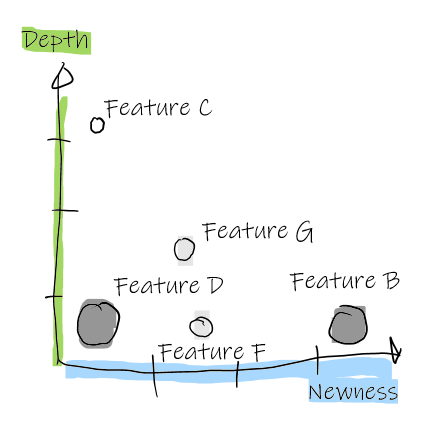When developing software, teams discuss what can be done and what cannot be done given available resources, skills and technology. Three dimensional scopes visualize the potential for this kind of negotiation: they question breadth, depth and the newness of features. This comes in especially handy, when the scope appears to be tightly defined.
Category Archives: 03 – Agile and user centered innovation
Creating user experiences – an organizational view
Some companies take a quite structured approach to creating user experiences. Others create user experiences unwittingly. Looking back, I detected six principles in regards to creating user experiences.
Continue readingThe case of a relevant UX problem
This is not about a Sherlock Holmes mystery and no engineer lost a thumb over it. Even though the machinery involved could easily achieve the latter. It is about industrial robots and tons of machinery to fold metal sheets into origami swans. But mainly it is about a case where creating the right user experience solved the relevant problem.
Continue readingCustomers, users or fans?
The stuff I find most exciting is making something work for the users or to put it in more modern terms: people have a great experience when using something I helped create. So I focus on users and user experience. Some people rather talk about customers and customer experience. Whatever the name, it is basically the same isn’t it?

Meet with users to create great products
Even though – as a UX professional – I must stress the importance of meeting users, I have to admit that the title of this article is not exactly accurate and just meeting users is not really the point. Having revealed this, I should probably explain what really matters when meeting users and give some indication on how to do it. This article covers two stars to road essentials: the UCD cycle and the UX levels.

Lets start at the beginning and lets review a first big challenge creators of great products are facing:
Continue readingFive or one guidelines for the minimal viable product
In our current project, we use an approach of the minimal viable product and we steer it with the story mapping technique. From the discussions in our team, here are five guidelines (or just one?) for such an endeavor to ensure a better work-life-balance.

User experience flow from stars to road
Companies, not surprisingly, want to make business. New products are not created just for fun but they should contribute to this overall plan. For that, a performing team combining a couple fields of expertise is an excellent asset. Each of these experts brings in their respective methodology. The article agile innovation from stars to road outlines a basic collaborative structure. This article is about one aspect: the users’ experiences.

Prioritizing Backlog Items
Agile practice recommends to focus on business value. Those items with the highest business value should be implemented first. At the goto zürich conference held in April 2013, one recurring topic was how to prioritize backlog items.
Continue readingMobile and Agile: Why can’t they get along?
This morning’s RE12 keynote was excellent. Steve Fickas described his use of a gaming engine and other resources to create a virtual environment for testing / requirement elicitation for mobile devices.
Fickas went on to describe how he interfaced mobile devices under development to the virtual environment and use this for testing in early stage development iterations (it is more controlled / manageable than the real world)
Agile innovation from stars to road
Taking ideas from the stars as innovation onto the road can feel like being stomped by a herd of elephants. It’s people and trade-offs. Well, even while we’re quite a reasonable lot most of the day, we still do a few quite stupid things. Especially if interests, values, and opinions clash. Here’s an agile way to innovate.

